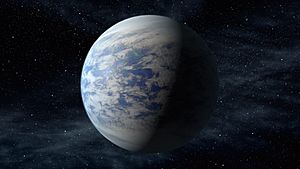Kepler-69c facts for kids
 |
|
| Discovery | |
|---|---|
| Discovered by | Kepler spacecraft |
| Discovery date | 18 April 2013 |
|
Detection method
|
Transit (Kepler Mission Method) |
| Orbital characteristics | |
| 0.64+0.15−0.11 AU | |
| Eccentricity | 0.14+0.18−0.1 |
| 242.4613 (± 0.006) d | |
| Inclination | 89.85+0.03−0.08 |
| Star | Kepler-69 |
| Physical characteristics | |
|
Mean radius
|
1.71+0.34−0.23 R⊕ |
| Mass | ~6 M⊕ |
| Temperature | 548 K (275 °C; 527 °F) |
Kepler-69c is a fascinating exoplanet that orbits a star called Kepler-69. An exoplanet is simply a planet that is outside our own solar system. Scientists discovered Kepler-69c in 2013 using the Kepler space telescope. This planet is much too hot for life as we know it, making it an uninhabitable world.
Contents
Discovering Kepler-69c
Scientists found Kepler-69c using a special method called the transit method. The Kepler space telescope watched thousands of stars, looking for tiny dips in their brightness. When a planet passes in front of its star from our view, it blocks a small amount of the star's light. This brief dimming tells astronomers that a planet is orbiting that star.
The Kepler Space Telescope
The Kepler space telescope was a NASA mission. Its main job was to search for exoplanets, especially those that might be similar to Earth. It launched in 2009 and observed a specific patch of sky. Kepler helped us find thousands of new planets.
What is Kepler-69c Like?
Kepler-69c is often called a "super-Venus." This means it's larger than our planet Venus but likely has a similar, very harsh environment. It's much hotter than Earth and probably has a thick, toxic atmosphere.
Size and Mass
Kepler-69c is about 1.7 times the size of Earth. It's also much heavier, with a mass of about 6 times that of Earth. This makes it a very dense and rocky planet.
Temperature and Atmosphere
The surface temperature on Kepler-69c is extremely hot, around 275 degrees Celsius (527 degrees Fahrenheit). This is hot enough to melt lead! Because of this extreme heat, any water on its surface would have boiled away long ago. Its atmosphere is probably thick and full of carbon dioxide, similar to Venus, creating a powerful greenhouse effect.
Orbiting its Star
Kepler-69c orbits its star, Kepler-69, much closer than Earth orbits our Sun. It completes one full orbit in about 242 Earth days. This short orbital period is another reason why the planet is so hot. Kepler-69 is a star similar to our Sun, but it's slightly smaller and cooler.
Why Kepler-69c is Uninhabitable
Even though Kepler-69c is in what scientists sometimes call the "habitable zone" (the area around a star where temperatures might allow for liquid water), its actual conditions make it impossible for life. Its close orbit and dense atmosphere create a runaway greenhouse effect. This means the planet traps a lot of heat, making it far too hot for liquid water or any known life forms to exist.
Images for kids
-
Artist's conception of a comparison between a Venus-like and Earth-like planet. Based on recent research, Kepler-69c is more likely a super-Venus, analogous to Venus but more massive, and completely uninhabitable.
See also
 In Spanish: Kepler-69c para niños
In Spanish: Kepler-69c para niños



